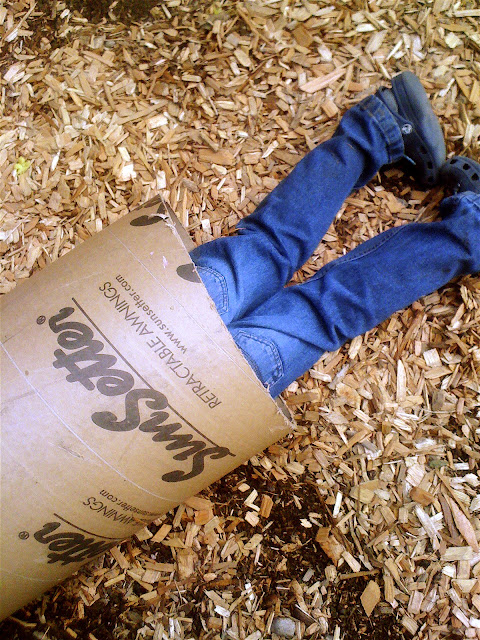
As a new parent, I was convinced that my daughter would grow up to be a sports playing, hammer wielding tomboy. After all, I was playing the role of stay-at-home-parent in our family, and I just assumed that my male influence would make it so. We didn't exactly
try to raise her in a non-gender specific way, but mom was the one heading off to the office, while dad handled childcare, cooking and cleaning. Not only that but we both preferred her in short hair and overalls, and for the first couple years of her life, whenever she was out with me, everyone just assumed she was a little boy, a mistake I didn't always correct. If anyone was raising a child outside the cultural expectations for a little girl, it was us.
I was pretty smug when she expressed a fondness for
The Who (a band I've always considered particularly masculine), knew the name of certain baseball players, or left the toilet seat up. I'd grown up in an academic and cultural era in which most of us believed in the power of nurture over nature, the idea that things like gender-specific behaviors and preferences were largely conveyed to children by society rather than genes. By the time I was a parent, however, the pendulum was swinging back the other way. There were now studies and articles arguing that gender-linked behaviors are almost entirely a matter of biology, a case that was bolstered, it seemed, by my own daughter, before she was 3, telling me, "You don't know about girls. Girls wear crowns." She then proceeded to wear a crown almost every day until she hit kindergarten, augmenting with pink and purple and tutus and just about every typically girlie thing one can imagine.
Bethe Almeras, the wonderful
Grass Stain Guru asked me (and a few other folks) yesterday to comment on an
Associated Press article about Egalia, a Stockholm preschool that seeks to teach children in as gender neutral a way as possible. I read the article on my phone while sitting in a restaurant awaiting the rest of our overwhelmingly female summer program board to assemble for dinner and drinks.
My initial reaction was to chuckle about the first sentence:
At the "Egalia" preschool, staff avoid using works like "him" or "her" and address the 33 kids as "friends" rather than girls and boys.
I chuckled not because I don't admire the effort, because I do. I still believe that the truth about nature versus nurture lies somewhere in between, and that my own efforts at gender-neutral parenting have borne fruit as my child enters her teenage years; definitely female, but not always stereotypically so. I chuckled because it struck me as the kind of thing I would have tried when I was a brand new teacher, discovered it was like trying to push water uphill, then abandoned it in the interest of choosing a battle I could actually win.
According to the article, however, breaking down gender roles is a core mission in the national curriculum for Swedish preschools. I also know that in Sweden, schools (like the rest of Scandinavia) are expected to adhere to the goals of their national curriculum, but are given the freedom to seek to achieve those goals in the way the teachers and administrators in that school see fit. And the fact that there is a "long waiting list" to get into the school tells me that there are a lot of parents eager to take part in the experiment.
Do I think that Egalia will succeed in creating a generation of children entirely free from their stereotypical gender roles? No. But do I expect that this approach will in both overt and subtle ways influence individual children in their attitudes about themselves and others when it comes to gender? Quite possibly, especially since the entire learning community, from teachers and administrators to parents, seem to be on board. It's an educational experiment, and if you've read here for long, you'll know that I think that's what education ought to be every day: a collaborative experiment between children and the adults in their lives.
I don't, however, encourage you to click through to this AP story if you want to learn more about Egalia. The writer has chosen to infuse it with much of her own bias: everything from putting the name "Egalia" in quotes (as if it's not a real proper noun -- you would never see "Bank of America" in quotes), to tossing out charged terms like "liberal," "radical," and "engineering equality." The writer clearly wants readers to find the whole idea ridiculous. Not only that, but there is very little about the rest of Egalia's curriculum beyond the silly-sounding idea of avoiding gender specific pronouns and a long diversion into how they try to create an environment that is tolerant of "gay, lesbian, bisexual, and transgender people" (something that is not unique to Egalia, but rather true of all Swedish schools). At the same time there are lots of quotes from critics, including from a University of a California Davis psychologist who had never heard of Egalia or any school like it before the reporter called him. The writer even goes out of her way to find an unrelated, ridiculous-sounding state-funded postdoctoral study to drop into the story.
I still believe that the Egalia experiment will result in much pushing of water uphill, but I also think it's a worthy experiment. One preschool will in no way undo the influence of biology or the rest of society, but it will be interesting to see what it
can do.




















































